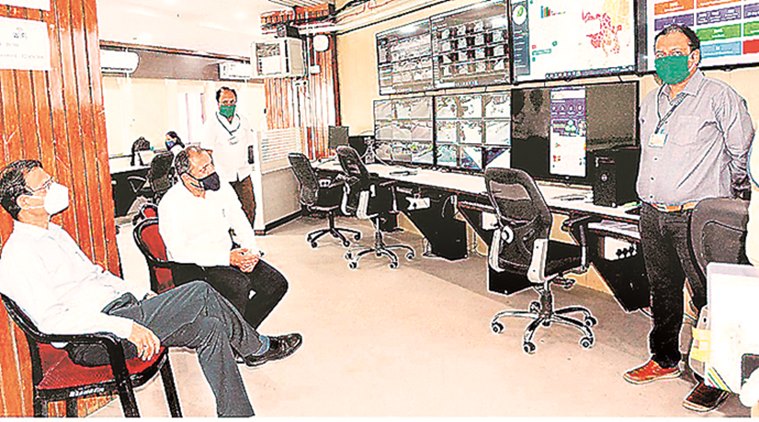 A Central team at a control room in Pimpri-Chinchwad in Pune. (Express photo)
A Central team at a control room in Pimpri-Chinchwad in Pune. (Express photo)
In Nirman Bhawan, which houses the Ministry of Health and Family Welfare, a lounge on the first floor, where joint secretary-level and above officers would gather to celebrate birthdays, has been functioning as a COVID-19 “war room” for about a month-and-a-half now.
This is where about 30-odd people — including doctors, data analysts, information communication technology specialists and public health professionals from various agencies — have been collecting and analysing granular data from the states to identify the gaps, or forecast a sudden surge in cases and warn the states to take action accordingly.
They have been divided into five teams, each tracking different sets of data, all projected onto five giant screens in the war room.
One team tracks the growth of cases and deaths, doubling time and identifies hotspots.
Another team keeps a watch on the availability of infrastructure, down to the district level.
A third team looks at future projections to assess the state-level preparedness, and shares this data with the states every day. “For example if there is a facility or a district where there is no assigned ventilator, we flag that to the state. We take inputs from states, analyse them and give them feedback,” said a team member.
A fourth group looks at the projections to see where the numbers are headed; and the last team tracks global trends vis-a-vis India, and sets deliverable goals for the states.
There is also a dashboard tracking social media, identifying fake news and information that needs to be relayed to the states among other things.
Explaining their work, a member of the team that tracks hotspots said: “Our job is basically to look at data and give inputs to the states or the ministry, as the case may be, so that they are prepared for the future. That is why we work with doubling time, rather than looking at the number of fresh cases each day, to detect a trend. When you work on doubling time, you can foretell a surge before it happens.”
A screen shows all the emerging hotspots like Ahmedabad and Indore as well as the existing ones like Mumbai, Pune and Delhi. And at the click of a mouse, all the relevant data, including the number of cases, deaths and doubling time, come up on the screen. “All the inputs go straight to the secretary,” said an official.
This was where the list of hotspots, that Health Secretary Preeti Sudan shared with states earlier this month, originated.
A committee room on the second floor has been converted into a second war room for Health Ministry officials, to relay feedback to states on a daily, sometimes an hourly, basis.